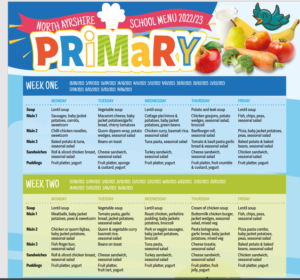What’s for lunch?

Please click on this link to view school lunch menus
Primary lunches
2 menus are rotated on a weekly basis.
All options are £2.05 and include a main meal, or a snack meal (baked potato or sandwich), with either a starter or a sweet. Snack meals include a piece of fresh fruit. Both meals include a drink.
Seasonal vegetables, salad bowls, potatoes, fresh fruit, yoghurts, home baking and free bread are available daily.
Vegetarian options are available every day on request.
Free school meals are available from EYC – P5 currently with tasty new menus. To access this service you must register for iPayimpact (this system will be used for all school activities too), even if you are entitled to a free school meal. The links can be found on the North Ayrshire Website or click here: https://www.north-ayrshire.gov.uk/education-and-learning/school-meals/school-lunches.aspx.
The menu will be available on the school website, shared on Seesaw and Twitter and can be found here https://www.north-ayrshire.gov.uk/Documents/EducationalServices/SchoolMeals/lunch-menu-mainland.pdf
Please take some time to discuss the options with your child and select them each evening.
As we must now run a cashless system, iPayimpact will be used to pay for all school events and activities e.g. residential, pantomime etc. The office staff are happy to help if you have any difficulty with this.
If you would like to apply for free school meals, Footwear and Clothing grants. Please click here: – https://www.north-ayrshire.gov.uk/education-and-learning/grants-and-allowances/footwear-clothing-and-free-school-meals.aspx
School lunches cost £2.05 and you can pay through Parent Pay.
https://www.parentpay.com/public/client/security/#/login
Our lunch hall offers our children a selection of hot and cold meals with a healthy salad bar.
Pupils are encouraged to sit with friends and enjoy their lunch before taking responsibility for tidying up their dishes.
The lunch hall is supervised by members of SLT, Classroom Assistants and Parent Volunteers. Should you wish to help out please contact the school office.
For those pupils who prefer a packed lunch we would encourage you to send in healthy options. Children with packed lunches enjoy them in the senior and infant open area. During the warmer weather children may eat their packed lunches outside.
Foods to put in a lunch box
Suggestions include:
- Fresh fruit
- Crunchy vegetables
- A meat or protein food such as slices of lean meat or hardboiled eggs
- Dairy food such as a cheese stick or slice, grated cheese, milk or yoghurt
- Starchy food such as bread, a roll, pita or flat bread, fruit bread or crackers
- Water.
Food suggestions for lunch boxes
There are lots of food choices available for lunch boxes. However, it can sometimes be difficult to decide which foods are healthy choices. Suggestions include:
- Fruit – best choices include fresh or tinned fruit. Dried fruit is sticky and high in sugar, so have it occasionally. Best left out of the lunch box are dried fruit bars and ‘straps’, which are very high in sugar, low in fibre and stick to children’s teeth causing tooth decay.
- Vegetables – try vegetable sticks with dip or a small container with mixed vegetables such as cherry tomatoes, carrot sticks, capsicum and cucumber. Chips and packets of crisps are best left for parties and special occasions.
- Milk, yoghurt and custard – include a small drink of milk (freeze overnight) wrapped in a cloth in the lunch box. Fruit yoghurts should be kept cool in an insulated lunch box. Best left out of the lunch box are ‘dairy desserts’ and flavoured milks, which are high in sugar.
- Dips, cheese and biscuits – pre-packaged or your own homemade versions of cheese and crackers are fine. Children enjoy mini packaged cheeses. Avoid sweet dips such as chocolate spreads. ‘Oven-baked’ savoury biscuits are just as high in salt and fat as chips and are best avoided.
- Different breads add interest – include a variety of bread, especially if children begin to lose interest in sandwiches. Try bread rolls, pita bread, flat bread, bagels, fruit loaf or buns, foccacias, scones, pikelets, muffins, crumpets, crispbreads, rice cakes or corn thins.
- Vary the fillings – fillings can include vegemite or other yeast extract, cheese (try different types), tuna, egg, sliced cold meats, baked beans, grated carrot and lettuce, chopped roast meat with pickles or chutney, and avocado. Dips like caviar (taramosalata), eggplant, chickpea (hommus), cucumber, yoghurt (tzatziki) or spinach also make good spreads. Avoid chocolate spreads, jams and honey, and fatty meats like salami and strasbourg.
- Muffins and cakes – try making your own muffins and cakes as a great way to include more fruit and vegetables. Examples include sultana, carrot, zucchini, banana or pumpkin. Donuts and creamy cakes are best offered at birthdays and special occasions instead of in lunch boxes.
- Muesli and ‘breakfast’ bars – almost all ‘bars’ are too high in sugar to include regularly, but cereal bars may be better for teeth than chewy sticky muesli bars. Try to avoid muesli bars and chocolate bars in lunch boxes. These are expensive and usually stuck together with fats and sugars.
Practical issues for busy families
Foods should be simple and easy to prepare, ready to eat and appetising after several hours storage in the lunch box. Foods such as sandwiches can be prepared the night before or on the weekend, frozen, then taken for each day’s lunch box. Suitable foods to freeze include:
- Bread
- Cooked meat
- Cheese
- Baked beans
- Mashed eggs
- Yeast or vegetable spreads such as Vegemite.
(Article 24 – The right to clean water and healthy food.)

